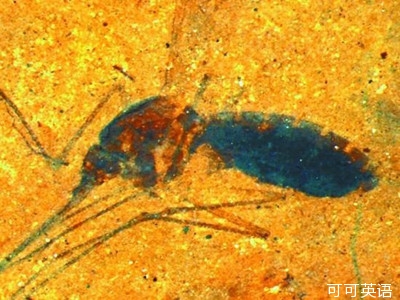(单词翻译:单击)
Forty-six million years ago, northwest Montana was a tropical forest of giant ferns, conifers and ginkgos.
距今4600万年前,蒙大拿西北是一片生长着巨大蕨类植物、裸子植物及银杏的热带森林。
Tiny primates lived there, as did rhinos and horses and crocs.
小的灵长类动物在这里生活,还有犀牛和马及鳄鱼。
Along with some less charismatic creatures: mosquitoes.
而且还有一些并不具魅力的生物:蚊子。
One of those millions of mosquitoes was then blown onto the surface of an ancient lake.
就是这数以百万计蚊子的其中一只被吹到一种古老湖泊的表面。

Unable to lift off, it eventually sank to the bottom.
由于不能再次振翅而飞,它最终沉入了海底。
And became a fossil.
之后逐渐演变成为化石。
The fossil mosquito was recently found.
而最近这块蚊子化石被发现。
And analyzed.
经过分析。
Scientists found that its belly contained iron, bound up in a molecule called heme—the compound in blood that carries oxygen.
科学家在其腹部发现含有铁,组成了一种被称为亚铁血红素的分子,这是一种在血液中携带氧气的化合物。
So it appears this sucker died and fossilized with a bellyful of blood—the only known specimen.
如此看来这家伙是带着一肚子的血液死后变成化石的—这是唯一已知的标本。
The findings appear in the Proceedings of the National Academy of Sciences.
该发现已经刊登在《美国国家科学院院刊》上。
Now I know what you're thinking.
现在我知道你正在想什么。
"This fossilized tree sap waited for millions of years, with the mosquito inside.
“这块里面有只蚊子的化石树液等待数百万年。
Until Jurassic Park scientists came along."
直到侏罗纪公园科学家们出现。”
Well, not quite.
嗯,并不完全如此。
DNA breaks down too quickly.
DNA分解非常迅速。
And this skeeter lived 20 million years after dinos went extinct.
而且这蚊子在恐龙灭绝之后又活了2000万年。
Though researchers say it may have dined on birds--which are, in some sense, blood relatives.
虽然研究人员认为这一物种可能被在某种意义上具有血亲关系的鸟当作正餐。


